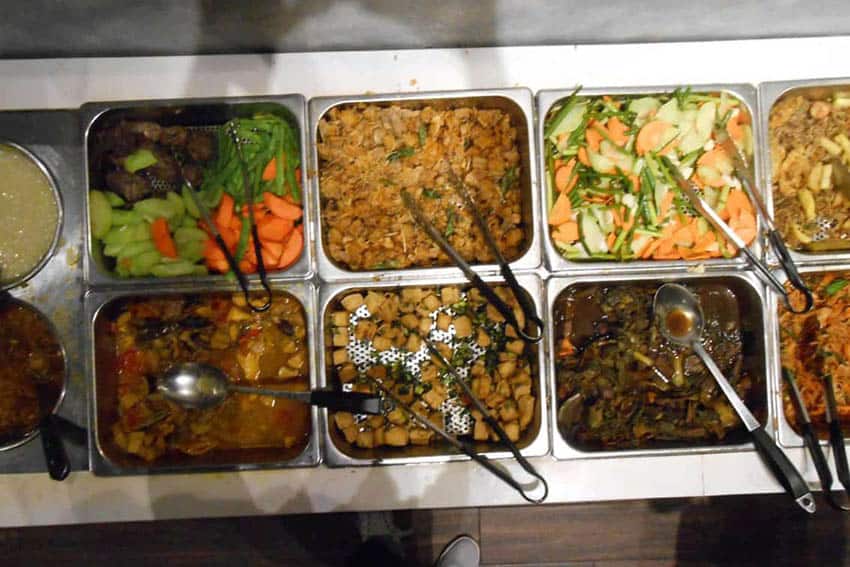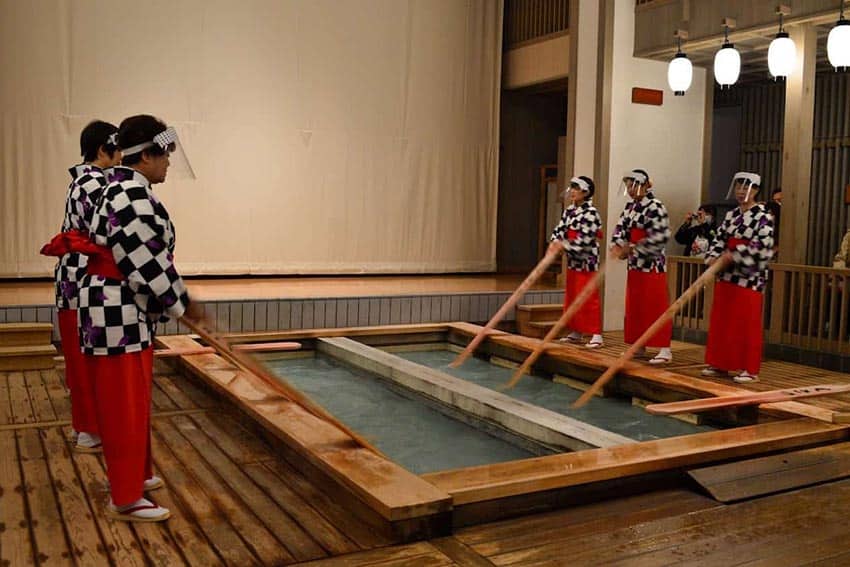
Life in Vietnam
By Lisa Petersson
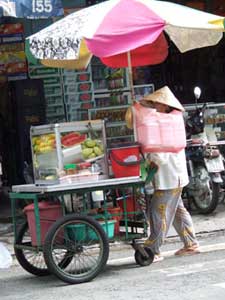
Every day it starts early, as a low rumble, at just after 5 am. By 6 am it has grown to a roar of voices, bells, music, bikes, metal clanking against metal, table legs being dragged along pavement, the squeaking of chains needing oil, and the odd cry from caged poultry. Within an hour the deserted streets are full of bustling activity, energy and purpose.
So what’s all the fuss about?
Food.
Vietnam has more than 500 national dishes and food plays an enormous part in Vietnamese culture and life. For the adventurous and enthusiastic visitor (which I, despite having spent 10 months here, see myself as), it is a mind-blowing and bewildering highlight of being here.
Before the sun has made it over the low rooftops of Ho Chi Minh City (formerly Saigon and still affectionately called so by the locals) and its rays lit the still dusky narrow alleyways, the clinking of pots begins: steam rising from rice cookers, broth boiling in giant pots, meat grilling over charcoal, vegetables in all shapes and colors are being peeled, washed and cut, and the distinct smell of fish sauce makes its merciless way around the nooks and crannies of the city.
Along the streets, people push their bikes, ingeniously adapted to any trade: converted into rolling soup kitchens; grills or juice bars; selling cooked corn on the cob or noodle soup.
Others carry smelly, spiky durian fruit; fried sticky rice cakes; bread, and doughnuts in heavy baskets across their shoulders.
And if you hadn’t already noticed that house-sized mountain of fresh fruit under an oversized parasol on a cart pushed by an old lady so tiny that only the top of her conical hat can be seen above the artistically cut pineapple crowning the pile, she makes sure that she has everyone’s attention by playing a piercing, cheery, keyboard version of ‘My heart will go on’ on a tape, on a roll.
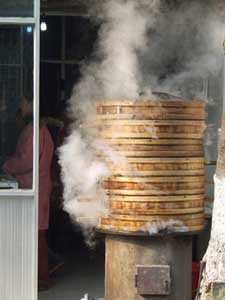
Outside my bedroom window, a woman hacks an enormous block of ice into tiny ice-cubes, as she does every morning, and I have learned from many previous failed attempts at a few more civilized hours of sleep, that nothing apart from heavy prescribed medication can help me now.
Instead, I must accept the life choices I have made which brought me here: I get up and announce (if only silently to myself in my head) a cheery ‘Good morning, Vietnam!’ at the brightening morning sky outside the window.
The day has truly begun, with a racket. The air is still cool, and the city workers gather in cafes along the street on child-sized stools, reading the paper while enjoying the day’s first coffee.
Though not having a great reputation in the world of coffee connoisseurs apart from being cheap, Vietnamese coffee, when served in Vietnam, is strong, usually comes on lots of crushed ice with plenty of sugar, or sweetened with thick condensed milk. It is addictively potent and good. It is also a great way to wake up from your early day sleepwalk and appreciate what is the best and most bustling part of the day.
The city markets are packed with women haggling for fresh-cut meat, fish, rice, and vegetables. Everything is bought fresh on the day here, and it is not unusual to go to the market every morning of the week.
The biggest market in Saigon is Ben Tanh, and although its enormous goods and souvenir section requires advanced skills of haggling for tourists, its food market and food court is a great place to watch the locals doing business and sit down for a cheap local breakfast.

From the mountains of Sapa in the north to the muddy Mekong delta in the south, this is likely to be ‘Pho.’ It is hard to overrate this dish’s importance to the Vietnamese. It is served everywhere and all over the country with regional differences, enjoyed not only for breakfast but at any time of the day, and the Vietnamese eat it many times a week.
I sit down at the market, on a bench by a little stall, after having negotiated what I want. The Vietnamese ‘mama’ in this pint-sized restaurant puts a serving of cooked rice noodles in a large bowl.
She places thinly cut raw beef on top, sprinkles some spring onions over it and pours steaming hot beef broth into the bowl. The beef cooks instantly.
But what would any Vietnamese dish be without herbs, lime, chili, and fish sauce? The way to an excellent bowl of Pho is in the very same ingredients, which I add myself to taste, a slow enjoyable task of ripping sweet basil, squeezing lime, and dashing fish sauce.
After a few tastings, the soup is perfect and my stomach is rumbling with appetite. There must be something special about this particular bowl of noodle soup that makes me endure it each morning despite the fact that the temperature is now reaching 30C, my forehead is shiny with sweat, the t-shirt is clinging to my back and my glasses are steaming up.

Through the steam I can just make out the supportive and endearing looks from the mama as I struggle to eat my soup with a spoon and chopstick like the locals, who all around me are getting down to the same sweaty business: with loud bangs popping open the plastic bag which covers ice-cool wet towels and wiping their necks, slurping loudly and dunking pieces of lettuce into the hot broth.
Vietnam, like many other parts of Asia, makes the cheap eats easy by having everything on display in colorful, artistic (and sometimes living) abundance.
All you have to do is point at whatever looks tasty and hope you are not about to eat a close relative to your pet Labrador who is faithfully waiting for you at home. The odds, however, of you unknowingly being served anything but the staple pork, beef, chicken, and maybe mutton, are very slim. Especially in the south, people are likely to find the northern canine delicacy as off-putting as you do.
Eating out in here is not reserved for the rich or for special occasions. Any space can serve as a restaurant, from a family’s front room where you squat down on small plastic furniture and enjoy the family specialities, to high-end world-class restaurants serving up gourmet Vietnamese cuisine. For a real taste of Vietnamese life though, you are better off staying on the streets.

By lunchtime I park myself on a little plastic chair on the pavement on the edge of the budget-touristy-but-also-bustling-with-locals: Pham Ngu Lao area.
The chair belongs to a lady with a crepe (Banh Xeo) kitchen consisting of bowls of fresh ingredients on a small table, a short concrete tube filled with hot coal, and a wok.
The Vietnamese crepe has little to do with its French namesake: The batter hits the pan with a sizzle and a very vague fragrance of coconut fills the air. To the mix, the chef adds pork, shrimp, mushrooms, and beans, before serving the folded yellow Banh Xeo piping hot, on a plate.
Having observed the Saigonese tucking into this popular dish many times, I place bite-sized pieces of crepe into leaves of lettuce, add some cucumber and herb leaves, fold it all into a little package which I dip into fish sauce spiked with chili and lime.
While I am tucking into my crepe, thousands of scooters drive past, some carrying whole families, others stylish businesswomen with Chanel sunglasses, black hair flowing behind them as they speed around the corner on their Italian bikes.
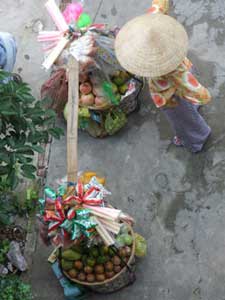
An old cyclo driver with thin legs and dark brown skin from spending his days slowly peddling along the streets in the hot sun, parks, climbs up in his passenger seat and lays back with his cap over his face for an afternoon siesta.
School children mingle outside a juice bar during lunch break and a motorbike taxi driver tries to talk me into doing a three-day tour to the Mekong delta, before spotting an old Vietnamese lady with too much shopping and offering his services to her instead. She is probably over 80 years old but swings her leg over the bike saddle like a teenager and they set off down the street.
Next to me a group of business men are enjoying piles of delicious deep-fried crispy frogs legs, fresh tofu, curried eel and spring rolls washed down with Saigon Beer in glasses filled with ice.
And while the grandmothers and housewives are busy cooking up feasts in their kitchens, in the streets a never-ending array of produce is being pushed or peddled past; bananas, melons, ice cream, jelly cakes, sugarcane and coconuts which are cut open for you should you fancy very exotic-tasting cold coconut milk drunk straight from the nut through a straw.
Though the long years of foreign occupation are happily over, and the Vietnamese are optimistically looking forward, a few influences from times past are apparent, and none more so, or more welcome, than the French style baguette.
It has a prominent place on the streets in the city, being sold from baskets carried by vendors in the mornings, and then a little later sold at impromptu stalls with a very Vietnamese twist of pate, dry cured and processed meat, pickled vegetables, coriander, cucumber, chilli and a splash of soy sauce, as a Banh Mi.

There is reason to wonder how a tub of pate survives unchilled in over 30C heat for days on end, or rather how one can survive consuming it, but once you are past this logical questioning, it is well worth a try.
Another tasty contender for the afternoon appetite, as a snack for the dedicated snackers that are the Vietnamese, are the fresh spring rolls: Banh Trang. These are made from damp rice paper filled with cold rice noodles, prawn, pork, spring onion, bean sprouts and lettuce. You take them away in a little plastic bag along with chilli sauce and peanut sauce for dipping, eating on the hoof or at home.
Night draws in early around the equator, which is a blessing for those of us who only need dusk as an excuse to crack open our first bottle of beer. Vietnam is allegedly home to the world’s cheapest brew and who am I to question this when a pint of the stuff can cost as little as six pence?
What you’re looking for is the sign which says ‘Bia Hoi’, or ‘Bia Tuoi’, meaning ‘fresh beer’. This stuff is brewed locally without preservatives and should be drunk within a couple of weeks of brewing.
Though after a while in the region my otherwise fragile western stomach can handle most things, I would recommend tourists taking it easy on this brew, though it should of course be sampled.

Despite its ‘unpredictability,’ my friends and I are loyal fans of the whole Bia Hoi experience: whether you go to a shabby-looking little eatery on a bustling street or opt for a quieter courtyard setting with adult size chairs and tables and maybe even tablecloths, the sign ‘Bia Hoi’ usually guarantees excellent and cheap eats, and is likely to get you talking to a few of your fellow drinkers.
At the very least you are likely to get involved in a never-ending exchange of ‘-Yo!’s (cheers!), lacking any more meaningful means of communication.
Thus, once the sun is set, we usually take a plastic seat on a pavement on a small street. The teenagers roam the streets on flashy Japanese bikes: lanky boys with hair slicked back and petite girls in heels and tops with obscure messages attempted in English, though with quirky grammar and unique spelling.
A barmaid brings us jugs of beer and we order curry, which here is not hot but aromatic – cooked with coconut milk, lime, chilli, lemongrass and served with crusty baguette.
A fresh, delicate lotus stem salad (Goi Ngo Sen) arrives. The Vietnamese love for this plant and flower is apparent everywhere: in graphics, art and food, symbolising purity and perfection. Finally, a seafood hotpot: mushrooms, leeks, fish and clams boiling in a clay pot on the table and we dip into it with our chopsticks and fish out whatever goodies we manage to catch.

A couple of older men on the table next to us offer us to try the sea snails and crab they have just ordered from a man pushing a seafood cart along the road and not long after we are prompted to raise our glasses every five minutes or so, to a resounding ‘Yo!’.
With a few words in each other’s language, but a lot of waiving of arms, a few drawings with a straw in spilled beer on the table, and much optimism, we manage to establish the essentials about each other, such as occupation, family, nationality, age and general feelings about Saigon.
Before leaving one of the men gives us his phone number, in a gesture of friendship. How we could ever communicate over the phone obviously does not cross his mind as he kick-starts his scooter and drives away happily, if somewhat unsteadily.
Vietnamese food is light and fresh, or so we tell ourselves a couple of hours later as a little cart with grilled minced meat in vine leaves comes past and we enjoy yet another snack.
The man with dried squid hanging off a frame of the back of his bike is popular with the beer drinkers who dunk strips of the dry, salty flesh into pots of chilli sauce.

Another vendor has a popcorn machine attached to his bike, and, as everyone has to make themselves known in this never ending noise of bikes and horns, he plays ‘Jingle Bells’ on a little transistor radio. The tune prompts a whole gang of kids to come running from a small alleyway, surrounding the vendor and receiving paper bags with warm popcorn.
But its not just food you can buy as you sit by the side of the road. A range of services and goods also go past.
Masseurs, of various legitimacy, cycle past; a set of talking scales are pushed along by a woman asking for only 4000 Vietnamese Dong (about 12p) to humiliate yourself in public, a vendor selling, and playing, cheesy Vietnamese pop tunes attract some young women, and a circus act with unfortunate children performing unpleasant tricks involving hot coal eating and sword swallowing, stops to entertain and attracts a large crowd of locals.
Other children are polishing the shoes of businessmen, and should you feel like your ears need a good clean you can have this publicly done too, by brave and very professional ear cleaners.
Though one should question some of the goings-on, and the signs of poverty are everywhere, there is also a spirit of entrepreneurialism here, born out of necessity and need for survival.

As we order another round of beers, the police turns the corner into the narrow street, in a pick-up truck accompanied by two stern-looking officers on motorbikes.
A short but intense frenzy breaks out with people moving tables, customers and bikes off the part of the pavement that authorities have decided should not be used for trade or parking.
The police confiscate a few tables and chairs, but before their van and blue lights have disappeared around the corner, new tables and chairs are presented, customers are encouraged to spread out along the ‘banned’ pavement, new customers invited to the again expanded outdoor restaurant and orders are taken. It is business as usual.
Saigon is dynamic and changing. A city bursting with energy and optimism, yet a place of extremes: poverty and wealth, soup kitchens and designer stores, the smell of incense and petrol, areas of slum and luxury.
But wherever you go, regardless of budget, people are cooking up, and are dedicated to, extraordinary food. Not just for culinary reasons, but because food is integral to life: It is culture, it is socializing, it is celebration and it is family.
As one Vietnamese proverb goes: ‘Heaven punishes, heaven reprimands. But heaven does none of this while people are eating.’
Price guide:
£1 = 30 000 VND (Vietnamese Dong)
Bottle of Saigon beer: 10 000 VND
1 litre of local Bia Hoi (fresh beer): 4 000VND
Bowl of Pho Bo (beef noodle soup): 15 000 VND
Fresh spring rolls (Banh Trang): 2 000 VND each
Plate of rice, grilled meat or fish and vegetables at local restaurant: 15 000 VND
For accommodation options, find unique Saigon hotels and interesting tours in Saigon.

Lisa Petersson was born in Sweden and studied art in England, Wales and Scotland. She and her husband spent a year and a half traveling in Australia, China, Hong Kong and Southeast Asia and then lived in Saigon for 10 months. Last year they traveled home by train through China, Mongolia, Russia and Latvia. “Since then,” she writes, “we’ve been living in Edinburgh, thinking about where we might go next.”
- Montreal’s Breweries Await Your Thirst - May 7, 2024
- Mother’s Day Ideas - May 6, 2024
- Exploring Kenya’s Night Markets - May 3, 2024



